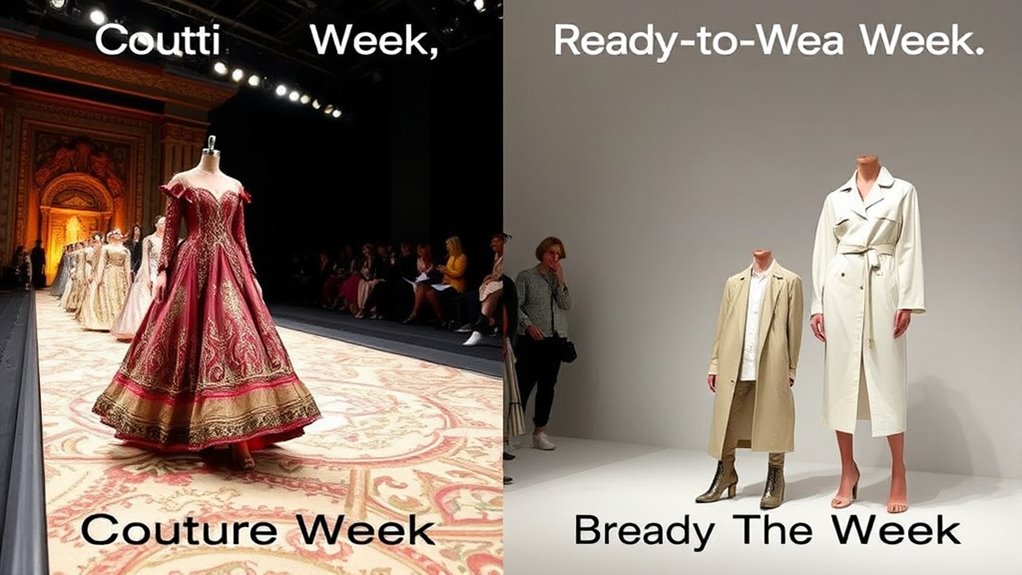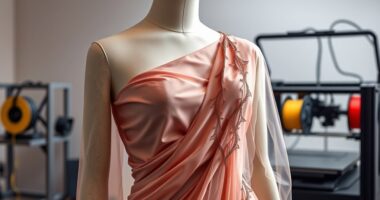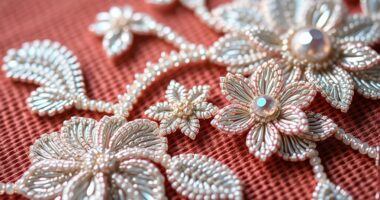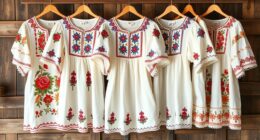Couture Week celebrates artistic craftsmanship, with detailed embroidery, luxurious fabrics, and pieces that take months to create, emphasizing innovation and technical mastery. It’s less about practicality and more about pushing creative boundaries. In contrast, Ready-to-Wear Week focuses on accessible, trend-driven collections designed for everyday use, with faster production and practical fabrics. To understand how these events shape the fashion world and influence your style, keep exploring the differences further.
Key Takeaways
- Couture Week emphasizes artistic expression, high craftsmanship, and intricate detailing, while Ready-to-Wear focuses on practical, trend-driven, and mass-produced designs.
- Couture pieces take weeks or months to create, showcasing technical mastery; Ready-to-Wear collections are designed for efficiency and broader accessibility.
- Couture showcases innovative, often impractical designs meant as artistic statements; Ready-to-Wear emphasizes wearable styles for everyday consumers.
- Couture Week highlights luxury fabrics and meticulous embroidery; Ready-to-Wear prioritizes durable, comfortable fabrics suitable for daily use.
- Couture influences future fashion innovations; Ready-to-Wear sets seasonal trends and caters to a larger, commercial market.

When it comes to fashion showcases, Couture Week and Ready-to-Wear Week serve distinct purposes, each highlighting different aspects of the industry. As you observe these events, you’ll notice that Couture Week emphasizes the artistry and meticulous fabric craftsmanship behind each piece, while Ready-to-Wear Week focuses on accessible, commercial collections designed for everyday wear. Couture Week is about showcasing the pinnacle of craftsmanship—every stitch, embellishment, and fabric choice is carefully executed by skilled artisans. These runway presentations are less about practicality and more about artistic expression, pushing boundaries to display the designer’s vision in its most elaborate form. You see intricate embroidery, hand-sewn details, and luxurious fabrics that often take weeks or months to create, making Couture Week a celebration of technical mastery and innovation.
In contrast, Ready-to-Wear Week (also called Prêt-à-Porter) centers on collections that are ready for the mass market. Here, the runway presentations are typically more streamlined and commercial, designed to appeal to a broader audience. While quality remains important, the focus shifts toward wearable designs that balance style with practicality. You’ll notice that fabrics are chosen for their durability and comfort, and the craftsmanship, though still high, is geared toward efficiency in production. The collections are produced in larger quantities, and the designs are often more accessible in price and style, making them easier to incorporate into everyday life. This event gives you a glimpse of what’s trending for the upcoming seasons, showcasing how designers interpret trends into more relatable pieces. Additionally, understanding the fabric craftsmanship involved in Couture Week helps highlight the extraordinary skills that set high fashion apart from mass-produced clothing.
Understanding the key differences helps you appreciate the industry’s diverse scope. Couture Week is about pushing creative boundaries, with each piece serving as a work of art that embodies the highest level of fabric craftsmanship. It’s a glimpse into the future of fashion innovation, although not necessarily intended for mass consumption. Meanwhile, Ready-to-Wear Week aims to democratize fashion, translating high concepts into practical collections that you can buy and wear. These runway presentations are more about setting trends and making fashion accessible, reflecting the evolving tastes of consumers. Both events play essential roles—Couture Week inspiring innovation and craftsmanship, and Ready-to-Wear Week shaping the commercial landscape—yet they serve very different audiences and purposes.
Frequently Asked Questions
How Do Pricing Strategies Differ Between Couture and Ready-To-Wear?
You’ll find that pricing strategies for couture and ready-to-wear differ greatly. Couture uses luxury branding and exclusivity marketing, so prices are high and tailored, reflecting craftsmanship and rarity. Ready-to-wear offers more accessible pricing, appealing to a broader audience with consistent, mass-produced designs. This approach allows brands to maintain their luxury image while reaching more customers, balancing exclusivity marketing with wider availability.
What Are the Typical Audience Sizes for Each Event?
You’ll find that couture shows attract a smaller, more exclusive luxury clientele, making the event highly intimate and selective. In contrast, ready-to-wear weeks draw larger audiences, including industry insiders and fashion enthusiasts, emphasizing event accessibility and broad exposure. The audience size reflects each event’s level of exclusivity, with couture prioritizing intimacy for elite clientele and ready-to-wear aiming for wider reach and visibility.
How Do Designers Select Collections for Couture Versus Ready-To-Wear?
Imagine you’re painting a masterpiece—each collection a carefully chosen palette. For couture, you select luxurious fabrics that demand intricate craftsmanship, focusing on exclusivity and artistry for runway presentation. Ready-to-wear collections rely on versatile, accessible fabrics suitable for mass production. Your choices reflect intent: couture aims to wow with one-of-a-kind pieces, while ready-to-wear emphasizes practicality and broad appeal, guiding your fabric sourcing and presentation style accordingly.
What Role Does Technology Play in Each Fashion Week?
You see, technology plays a crucial role in both fashion weeks. Digital innovation allows designers to showcase collections virtually, reaching a global audience instantly. Social media amplifies excitement, enabling you to share behind-the-scenes moments and runway highlights in real-time. Whether it’s live streaming shows or interactive content, technology helps you stay connected, informed, and engaged, making fashion weeks more accessible and dynamic than ever before.
Are There Different Marketing Approaches for Couture and Ready-To-Wear?
You’ll find that marketing approaches differ between couture and ready-to-wear. For couture, luxury branding takes center stage, emphasizing exclusivity and craftsmanship through high-end campaigns. Influencer collaborations are more selective, targeting niche audiences. In contrast, ready-to-wear brands often use broader marketing strategies, leveraging social media and influencers to reach mass markets. Both focus on luxury branding but tailor their efforts to appeal to their specific audiences and brand positioning.
Conclusion
So, here’s the irony: while Couture Week showcases the pinnacle of exclusivity and artistry, it’s often out of reach for most. Meanwhile, Ready-to-Wear Week offers more accessible styles, yet it’s where mass production rules. You might think the luxury is in the rarity, but sometimes, it’s the everyday collections that truly influence what ends up in your closet. After all, fashion’s real magic is how it seamlessly blends the extraordinary with the everyday.










